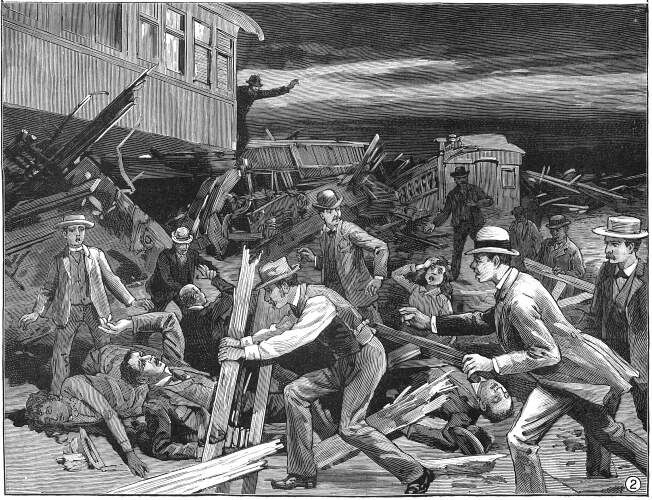|
||||||
  
 | ||||||
|
THE ILLINOIS RAILROAD ACCIDENT.
ONE of the most terrible railroad accidents ever recorded in this country occurred about three miles east of Chatsworth, Illinois, on the night of August 10. An excursion train for Niagara Falls had been made up along the line of the Toledo, Peoria, and Western Railroad. When it left Peoria it consisted of a baggage-car, a special car occupied by the Superintendent of the road, five passenger coaches, two chair cars, and six sleepers, and was drawn by two engines. Every berth was occupied in the sleeping-cars, and the other cars were filled with excursionists, the whole number of passengers being over six hundred. The train passed through Peoria at 11:45 p.m. Three miles further along on the road there was a shallow "run," not more than fifteen feet wide and ten feet deep, which the recent drought in that region had made dry. This was crossed by a wooden trestle bridge supported by timbers. As the train approached this it was running at the rate of thirty-five miles an hour with a clear track. Just before reaching it the engineer of the forward engine noticed flames licking up through the wooden structure, but too late to stop the train. His engine crossed the gulch, but the burning bridge gave way, the tender broke from the engine and fell in, the second engine ploughed furiously into the farther bank, and cars came crashing with terrific force upon one another, telescoped throughout their length, and piled in splinters over the broken and burning trestle. The sleeping-cars stopped short of the horrible gap, but were badly shaken up. The scene that followed it is impossible to describe. The hapless passengers of the forward cars were, almost inextricably mingled in the shattered mass. The engineer of the second engine was instantly killed, and the fireman seriously injured. Out of the first car only four persons were rescued alive, and they were badly hurt, all being crushed by the second car, the bottom of which rested along the tops of the seats of the first. The third was piled upon the second. The next three were smashed and splintered, and most of their occupants were among the wounded. To add to the midnight horror, the flames were making their way in the shattered debris, and there was no water at hand. After a long contest the fire was extinguished, mainly by smothering it with dirt, which had to be dug up with the hands or any improvised implement that could be seized. While this was going on amid the shrieks of the injured victims and the terrors of those who escaped, every effort was made to extricate the dead, the dying, and the wounded. Help was summoned from the nearest towns along the road—Gilman, Piper City, and Chatsworth, and most of the dead and helplessly injured were sent to the latter place, where the Town-hall was turned into a hospital and the railroad station into a morgue. The number of the killed and injured is not definitely known. An official estimate gives the former as 16, and the latter 279. Half the number wounded were able to go to their homes. The robbery of some of the helpless victims by miserable wretches who were not identified led to the suspicion that the bridge had been set on fire for the purpose of wrecking the train and giving opportunity to plunder the passengers, but there, was no other evidence to justify this horrible suspicion. As usual, there were many cases of heroism as well as of meanness displayed in connection with this accident, and every effort was made by most of the uninjured passengers, the officers and employees of the road, and the inhabitants of the adjacent villages to take decent care of the dead and mitigate the sufferings of the living. The immediate facilities were meagre, as the disaster occurred at a lonely spot, but resources were speedily drawn from a distance. Bodies not identified and taken in charge by friends of the dead were sent to Peoria, and as soon as possible the wounded were transferred where proper care could be bestowed upon them. They lived mostly along the line of the Toledo, Peoria, and Western road and its western connections as far, as Iowa.
This page originally appeared on Thomas Ehrenreich's Railroad Extra Website
|
||||||
|
|
|
|||||




